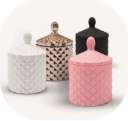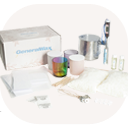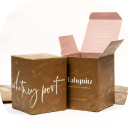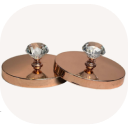Candle Safety
PLEASE CAREFULLY READ THIS INFORMATION ABOUT CANDLE SAFETY.
Decorative and fragranced candles are very popular as an attractive addition to your home décor, but they are also a growing concern with the Fire Service and Safety organizations. When asked recently what he saw as the greatest cause of accidental home fires today, an expert in the field of fire investigation quickly replied, "candles".
This isn't to say that all candles are dangerous or that using them is discouraged. If used properly they can be a beneficial source of enjoyment for many people, however, when used improperly, candles have caused significant loss of life, injury and loss of property. According to the U.S. Fire Administration (USFA), the soaring popularity of candles has led to an increase in reported candle fires. The USFA currently estimates that candles are responsible for approximately 10,000 residential fires each year, along with 1,000 civilian injuries, 85 fatalities and $120 million in property loss.
According to the National Fire Protection Association Journal article, "Candle Fires on the Rise", residential fires caused by candles have more than doubled over the past decade.
In addition to being a fire hazard, improperly used candles can generate a significant amount of soot. This soot can damage the walls, floors and ceilings of your home as well as your personal belongings.
According to a 2001 pilot study of candle fires by the Consumer Product Safety Commission (CPSC), by far, most candle fires were caused by combustibles being too close to the candle. The next most common cause of candle fires was due to the candle falling over or being knocked over by wind, doors, children or pets.
CANDLE SAFETY TIPS
- Always keep a burning candle within sight. Extinguish all candles when leaving a room or before going to sleep.
- Never burn a candle on or near anything that can catch fire. Keep burning candles away from furniture, drapes, bedding, carpets, books, paper, flammable decorations, etc.
- Keep candles out of the reach of children and pets. Do not place lighted candles where they can be knocked over by children, pets or anyone else.
- Read and carefully follow all manufacturer instructions.
- Trim candle wicks to 1/4 inch each time before burning. Long or crooked wicks cause uneven burning and dripping.
- Always use a candle holder specifically designed for candle use. The holder should be heat resistant, sturdy and large enough to contain any drips or melted wax. Be sure the candle holder is placed on a stable, heat-resistant surface.
- Keep burning candles away from drafts, vents and air currents. This will help prevent prevent rapid, uneven burning, smoking and excessive dripping. Drafts can also blow lightweight curtains or papers into the flame where they could catch fire. Ceiling fans can cause drafts.
- Keep the wax pool free of wick trimmings, matches and debris at all times.
- Do not burn a candle for longer than the manufacturer recommends.
- Always burn candles in a well-ventilated room.
- Extinguish the flame if it comes too close to the holder or container. For a margin of safety, discontinue burning a candle when 2 inches of wax remains (1/2inch if in a container). This will also help prevent possible heat damage to the counter/surface and prevent glass containers from cracking or breaking.
- Never touch or move a votive or container candle when the wax is liquid.
- Extinguish pillar candles if the wax pool approaches the outer edge.
- Candles should be placed at least three inches apart from one another. This is to be sure they don't melt one another, or create their own drafts that will cause the candles to burn improperly.
- One of the safest ways to extinguish a candle is to use a candle snuffer, which helps prevent hot wax from splattering.
- Flashlights and other battery-powered lights are much safer light sources than candles during a power failure.
- Never use a candle as light when you go into a closet to look for things.
- Never use a candle for light when fueling equipment such as a lantern or kerosene heater. Install a smoke detector in every room where candles are burned.
-
TAKE SPECIAL PRECAUTION WITH GEL CANDLES
Gel candles have become increasingly popular because of their beauty and long-burning characteristics. An eight-ounce gel candle will burn 100 hours or more, increasing the risk for injury and fire beyond that of regular candles.
The concern about gel candles is not so much with the gel itself, but rather with the:
- Type of wick used
- Container the candle is set in
- Embedding of combustible materials in the gel Amount of fragrance added to the gel
-
WICKS
Cotton and paper-cored wicks are generally not used in gel candles because of their tendency to sag or lean over during the manufacturing and burning process. Zinc-cored wicks are used because of their ability to stand straight in the hot gel during both manufacturing and burning.
Wick length and placement are important for candle safety. Wicks should be trimmed to 1⁄4 inch above the gel surface. Long wicks create a very tall flame that burns in an irregular pattern. If the wick is not placed properly, it causes localized overheating of the container and a liquid pool of hot wax or gel. Such conditions can cause uneven temperature dissipation and possible cracking of the container.
-
CONTAINERS
Containers should not be combustible, such as plastic or wood. Gel candles can be created in almost any type of glassware as long as it can withstand heat. Gel works best in containers between 2 and 3 inches in diameter, and is not recommended for use in containers over 4 inches in diameter.
Glass containers with narrow mouths are not recommended due to the closer proximity of the flame to the wall of the container.
Embedded Objects
Combustible materials such as wood and plastic should never be embedded into a gel candle. Only non-combustible materials, such as glass marbles, rocks or shells, should be used.
-
FRAGRANCE
Fragrance in gel candles plays a significant role in the safety of these types of candles and has been a major factor in candle fires. The fragrance needs to be compatible with the solubility of the gel. There are fragrances that are formulated specifically for gel candles. The most important factor in the fragrance selection is the flash point, or the temperature at which a material ignites. Most fragrances have flashpoints of 140°F and higher. A preferred fragrance flashpoint would be 170°F or higher.
Please refer to your fragrance's Safety Data Sheet to learn more about your fragrance's recommended use and safety information. All Safety Data Sheets are available in the Library here.
Many candles have been recalled due to the fire hazard created by their design. To see what products have been recalled, go to the CPSC website. Use their search page and look for candle recalls.











